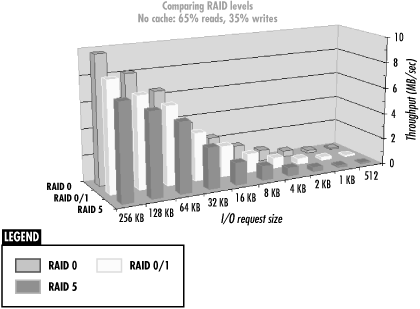Selecting a RAID Configuration
Choosing among different RAID configurations requires an understanding of the explicit cost/performance trade-offs involved. Figure 10-35 compares the performance of striping (RAID 0), striping and mirroring (RAID 0/1), and striping with parity (RAID 5) on a mixed read/write workload that is 50% sequential and 50% random. Four identical data disks were configured in each instance. RAID 0 disk striping improves disk performance, but generally only for very large blocks. To gain the benefits of disk striping, you must choose a stripe unit smaller than the size of the average I/O request. The stripe unit here was 32 KB. The most noticeable performance improvement occurs with 64 KB blocks that span two disks. Be sure to configure enough SCSI bandwidth to match the disk bandwidth of a striped disk array. Otherwise, the performance benefits fail to materialize. In this set of tests, internal SCSI bandwidth appeared to be a limiting factor above 64 KB blocks.

Figure 10-35. Comparing RAID Levels 0, 5, and 0/1 with no cache
RAID 0/1 has similar performance to RAID 0, but is expensive to configure, requiring twice as many physical disk storage devices. Disk mirroring does cause some loss of performance at high throughput levels because each write must be performed twice, ultimately creating contention for storage processor internal paths. RAID 5 suffers from a ...
Get Windows 2000 Performance Guide now with the O’Reilly learning platform.
O’Reilly members experience books, live events, courses curated by job role, and more from O’Reilly and nearly 200 top publishers.

